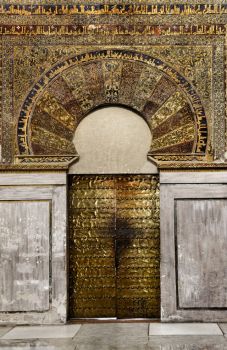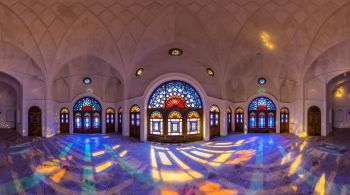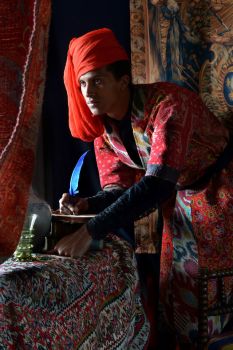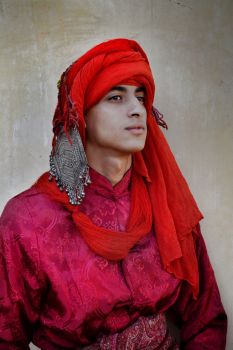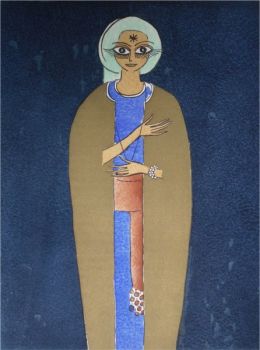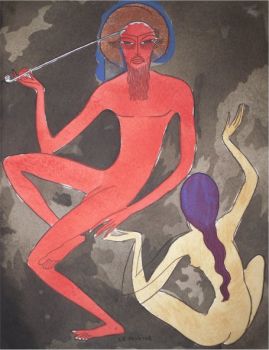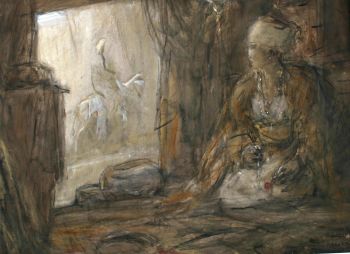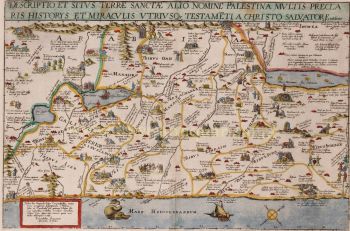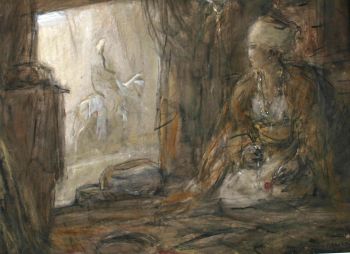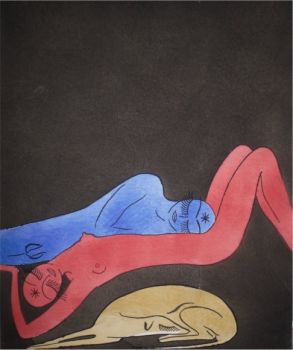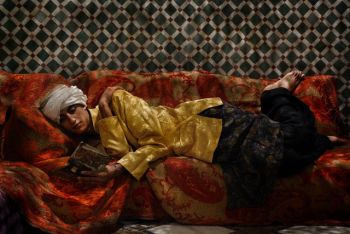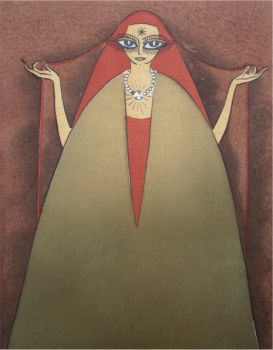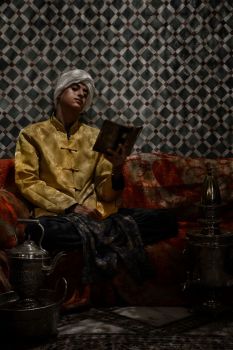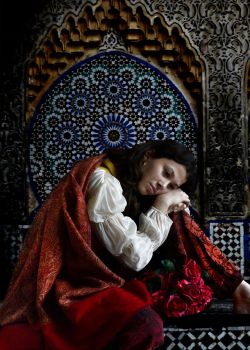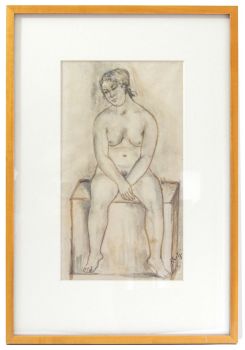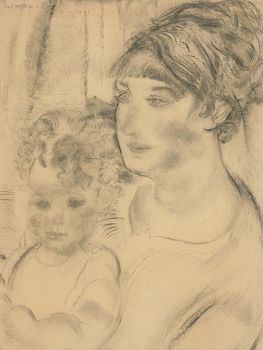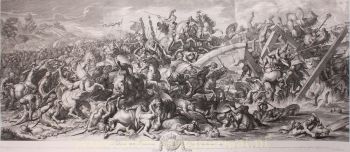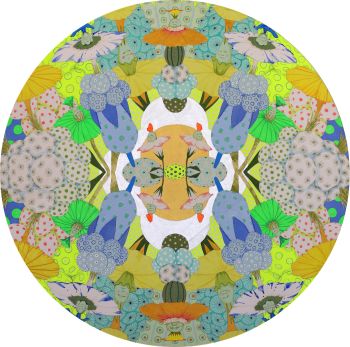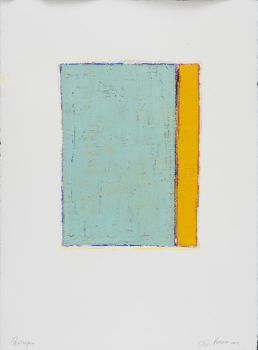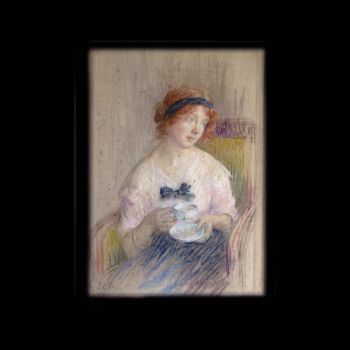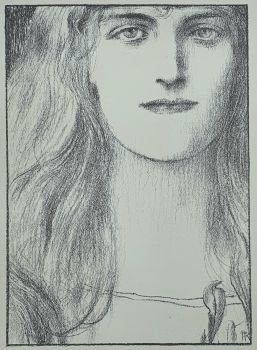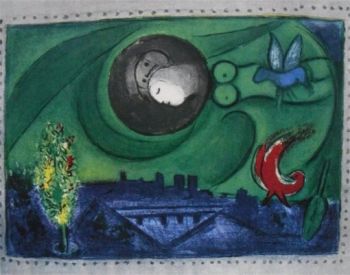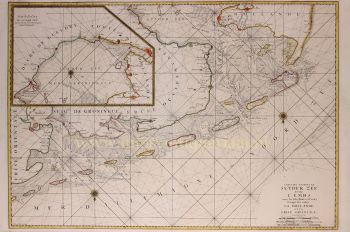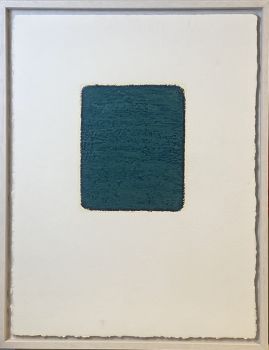Printed and bound at the first Arabic printing office in Lebanon 1776
Monastery of Saint John the Baptist at Dayr al-Shuwayr
PaperLeather
Currently unavailable via Gallerease
- About the artworkKitab al-Injil al-sharif al-tahir wa-al-misbah al-munir al-zahir muqassaman kanayisiyan madar al-sanah hasaba tartib al-Anba al-Qiddisiyin al-Sharqiyin [= Book of the liturgical Gospels].
Dayr al-Shuwayr (or Dhour el Choueir, in Lebanon), Dayr Mar Yuhanna [= Monastery of Saint John the Baptist], [1776]. Folio (31.5 x 22.5 cm). A Greek Melkite Evangeliary in Arabic, with each page in a border of thick-thin rules, pp. 245-300 printed in red and black, and a woodcut Madonna and child. The title-page has been sophisticated, probably in the 18th-century, and appears to be a badly inked proof that has been touched up in manuscript. Bound by the Dayr al-Shuwayr Monastery in contemporary gold- and blind-tooled reddish-brown goatskin morocco, each board with a gold centrepiece.
Very rare second Arabic edition (the first to be printed in Lebanon) of the four Gospels arranged for liturgical use in the Greek Melkite Church, to make readings for services according to the day of the year: a so-called Evangeliary or Evangelion. It was intended primarily for Arabic-speaking Christians in the Middle East, rather than for missionary work. The first Arabic edition was printed and published at Aleppo in 1706. Al-Shamas Abdallah Zakher (1684-1748), son of an Aleppo goldsmith, worked at the Aleppo printing office but had to flee in 1722 because of disputes that were to lead to the 1724 schism in the Melkite Church. Zakher established the printing office of the Melkite monastery of St. John the Baptist at Dayr al-Shuwayr in the Lebanese Kisrawan mountains, where he produced a psalter in 1734. He is said to have been skilled in jewelry-making and cutting in metal and wood, and to have cut the punches for the 1734 Arabic type. The printing office produced about 70 Arabic editions before it closed in 1899.
With marginal manuscript notes in Arabic script, the stamp of a Diyarbakir (in Anatolia, eastern Turkey) library in the margin of the last page. With the title-page sophisticated as noted, some mostly marginal water stains, an occasional small stain, a tiny and unobtrusive worm hole in the second half, but mostly in good condition and with large margins. The binding rubbed and slightly chipped, with the front hinge and fore-edge corners restored and the inside front hinge reinforced. Very rare early example of an Arabic liturgical work, printed and bound at the Monastery of St John the Baptist in Dayr al-Shuwayr, Lebanon.
Darlow & Moule 1661; KVK & WorldCat (3 copies); Schnurrer 360; for Zakher: J.E. Kahale, Abdallah Zakher (2000); Hanebutt-Benz et al., Middle Eastern languages and the print revolution (2002), pp. 179-181. - About the artistThe Basilian Chouerite Order of Saint John the Baptist is a religious order of the Melkite Greek Catholic Church. The Latin name of this order is Ordo Basilianus Sancti Iohannis Baptistae, the French name is Ordre Basilien Chouerite de Saint Jean Baptiste, the abbreviation used after the name is B.C.
This order was found in 1696 by five monks (including Neophytos Nasri) who left the Balamand Monastery to look for a quite place where to better follow the rule of Saint Basil. They settled in 1710 in the village of Choueir (or Dhour El Shuwayr, near Khinchara) in Mount Lebanon using the little church of Saint John the Baptist, from which they took the name and that is still their motherhouse
In 1733 Abdallah Zakher set up an Arabic language printing press using movable type at the monastery of Saint John at Choueir, the first home made press in Lebanon.[4] In 1757 Pope Benedict XIV approved their particular rules, and the final approval from Rome was given in 1772.
The Basilian Salvatorian Order soon became one of the two main religious orders of the Melkite Catholic Church. The other order was the Basilian Salvatorian Order. According to their tradition, the Basilian Salvatorian Order had a more missionary aim, while the Basilian Chouerite Order was more contemplative. The Basilian Salvatorian Order recruited in the areas of Damascus and South Lebanon, while the Basilian Chouerite Order recruited in the areas of Aleppo, Homs, North Lebanon and Galilee. Attempts to unite these two orders in the 18th century failed: the opposition between them and between the different communities from which they recruit members is an important aspect to understand in the early history of the Melkite Catholic Church.
Between 1824 and 1832 the order split into two branches: the Basilian Alepian Order (formed mainly by monks who came from Aleppo area), and Baladites or Basilian Chouerite Order (who came mainly from Lebanon and Galilee). The order founded its seminary in 1880 and run many parishes in the Middle East. Three Melkite Patriarchs and about 36 bishops were members of the Basilian Chouerites.
The first Arabic edition was printed and published at Aleppo in 1706. Al-Shamas Abdallah Zakher (1684-1748), son of an Aleppo goldsmith, worked at the Aleppo printing office but had to flee in 1722 because of disputes that were to lead to the 1724 schism in the Melkite Church. Zakher established the printing office of the Melkite monastery of St. John the Baptist at Dayr al-Shuwayr in the Lebanese Kisrawan mountains, where he produced a psalter in 1734. He is said to have been skilled in jewelry-making and cutting in metal and wood, and to have cut the punches for the 1734 Arabic type. The printing office produced about 70 Arabic editions before it closed in 1899.
Artwork details
Related artworks
Tilmanus Nicolaus Maastricht
Missale Romanum with Dutch silver mounts1788 - 1792
Price on requestJacob J. Roosjen SRI
Engelbert Kaempfer
ENGELBERT KAEMPFER BOOK1651 - 1716
Price on requestZebregs & Röell - Fine Art - Antiques
Antonie Derkinderen
Memory book Exhibition of Dutch Painting1892
Price on requestKunsthandel Pygmalion
Antonie Derkinderen
Memory book Exhibition of Dutch Painting1892
Price on requestKunsthandel Pygmalion
Hermann Nitsch
"UNDER MY SKIN" Signed book incl. small artwork and DVD in a matching box2010 - 2014
Price on requestGallerease Selected
LAWRENCE WEINER
"SKIMMING THE WATER [MENAGE A QUATRE]" Signed book plus small artwork2010 - 2014
Price on requestGallerease Selected
Engelbert Kaempfer
ENGELBERT KAEMPFER BOOK1651 - 1716
Price on requestZebregs & Röell - Fine Art - Antiques
1 - 4 / 22Elisabeth Treskow
Afghan lapis lazuli inlaid with gold on a silver stand1950 - 1960
Price on requestJacob J. Roosjen SRI
1 - 4 / 24- 1 - 4 / 24

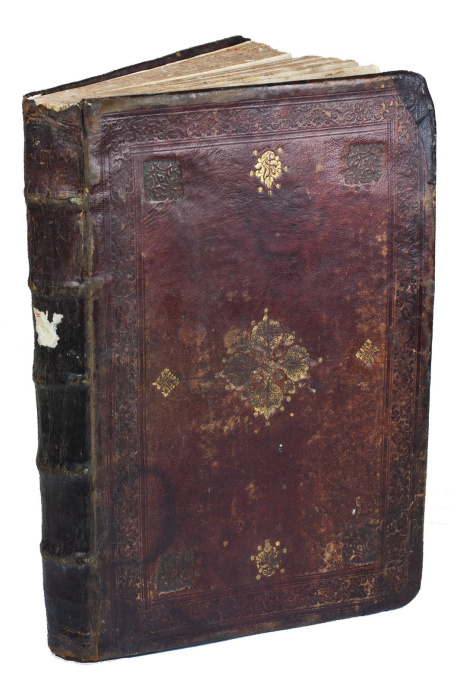










!["SKIMMING THE WATER [MENAGE A QUATRE]" Signed book plus small artwork by LAWRENCE WEINER](https://media-2.gallerease.com/images/442bfd5f-fc31-4e18-a2fa-ee0c08eade64/350x350/skimming-the-water-menage-a-quatre-signed-book-plus-small-artwork.jpg)








